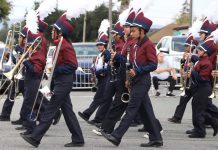Hollister
– The San Benito High School Board of Trustees has decided to
give the Navy Junior ROTC program a fighting chance instead of
retiring it altogether, following several protests from students
and parents involved with the classes.
Hollister – The San Benito High School Board of Trustees has decided to give the Navy Junior ROTC program a fighting chance instead of retiring it altogether, following several protests from students and parents involved with the classes.
Rather than disbanding the program, Trustees voted to search for an ROTC instructor for the remainder of the summer. If the search is successful, the program can continue on a probationary basis, despite low enrollment.
If a teacher with the proper certification cannot be found in time, however, the program will be canceled and students who had signed up for ROTC will be enrolled in either a physical education class or their second-choice elective class, depending on what graduation credits they most need.
Students and parents were glad that the program had not been canceled outright, but called the three-week deadline before school starts “unrealistic.”
“Why don’t you give us a few more weeks, a little cushion?” said one parent who did not identify himself. “If you’re going to give it a chance, give it a real chance, not a half-assed chance.”
SBHS Superintendent Jean Burns Slater said the district office would be issuing letters and phone calls to about 40 ROTC instructors who had indicated interest in working in the northwest region, which includes California, Washington and Oregon as defined by the ROTC. The district will also be advertising through more conventional means such as specialized publications. While technically the ROTC will allow the program to continue if a civilian substitute takes the reins of the program temporarily, the board determined this would be an inappropriate option for its program.
“We’re very leery of putting someone without a general sense of experience with the NJROTC in charge of that program,” Slater said. “Especially because we will only have one instructor.”
The district and booster club agreed to work together to find and pay for advertising and recruitment sources for a new instructor. One parent is currently investigating whether he could serve as a temporary instructor, as well. The booster club is also investigating getting a teacher on loan from a neighboring school district with a particularly successful ROTC program.
“If we can get an instructor we can prove how good and committed we are,” club President Caroline Garcia-Haro said. “We just have to put the word out with the military as much as we can.”
Slater suggested that the booster club could help support the ROTC program in a number of ways beside fundraising efforts, including soliciting sponsorships from community organizations.
“Parents can help supervise the extra-curricular activities, which are important to the program, or trips that the students might take on a Saturday,” she said. “They can work on recruiting students from other schools and at the high school, and the organizational skills they can provide are very important.”
The NJROTC is a program sponsored by the Navy. It’s designed to impart the values of patriotism and good citizenship upon students, encourage them to finish high school, seek a college education and stay away from gang activity. While it does provide information to students considering a career in the Navy, and students who enlist with an NJROTC background have a few advantages over other sailors, finding recruits is not the main goal of the program.
SBHS’ program has been on probation since November 2005 as enrollment has never topped 100 students, the Navy’s minimum requirement. Ideally, said Burns, the program would involve around 10 percent of the student body, or 265 students at the low end. Both NJROTC instructors resigned at the end of the school year and school officials determined that the cost of staffing – $160,000 in salary and benefits, only $50,000 of which is reimbursed through the Navy – did not justify continuing a program when class sizes averaged nine or 10 students each period.
The district’s budget for the 2007-2008 year, which was passed in June, is running at a nearly $500,000 deficit. Cutting the NJROTC program is one option district officials hoped would help ease that defect while affecting a minimal number of students.
At the July 19 meeting of the trustees, parents and students filled the boardroom, many in uniform or booster club T-shirts, to plead their case. Many students said the disbanding of the NJROTC unit would effectively eliminate their social circles at school and attested to the many ways in which the program had improved their academic performance and confidence.
Parents had cited concerns over a growing gang problem in the community and said the NJROTC was an effective deterrent to such an element. Many also bemoaned the fact that disbanding the program would make certain scholarships and post-high school opportunities unavailable to their children.
Danielle Smith covers education for the Free Lance. Reach her at 637-5566, ext. 336 or ds****@***********ws.com.









